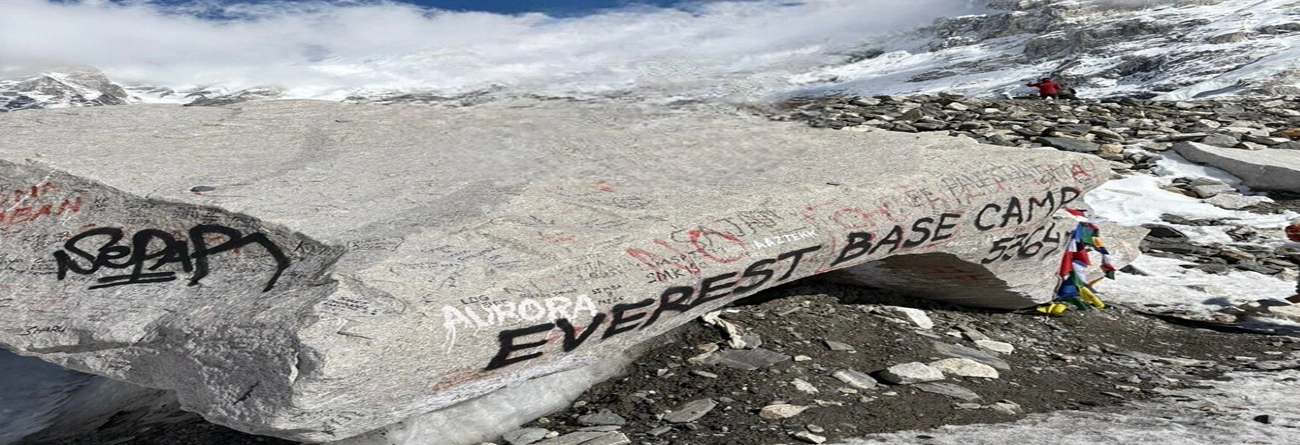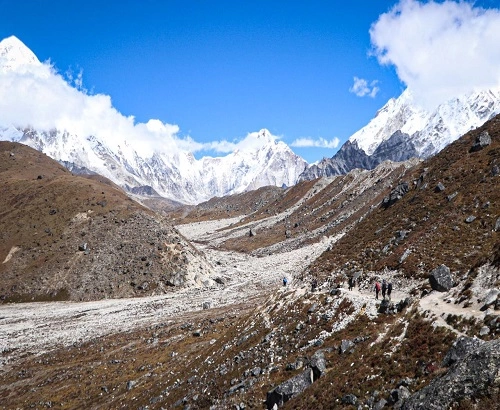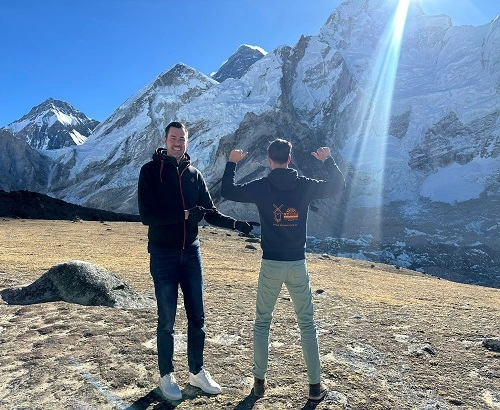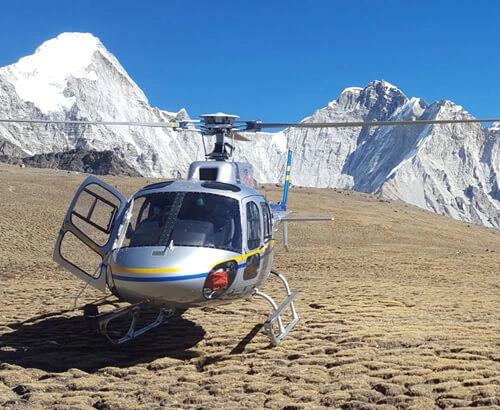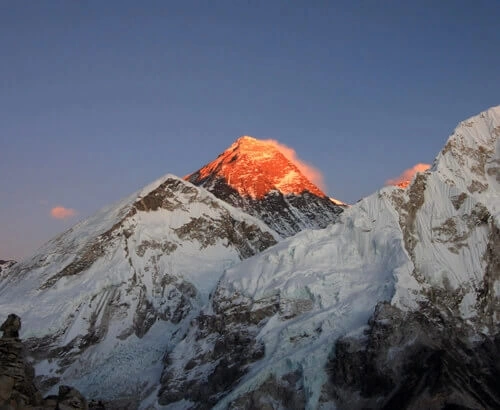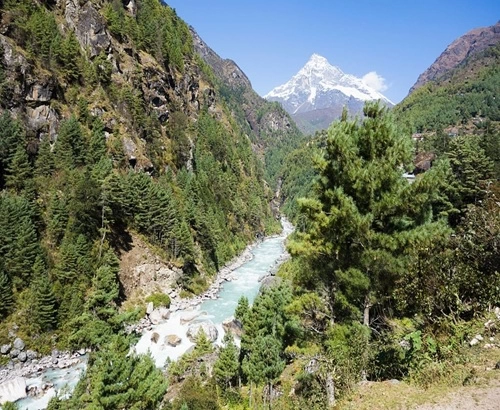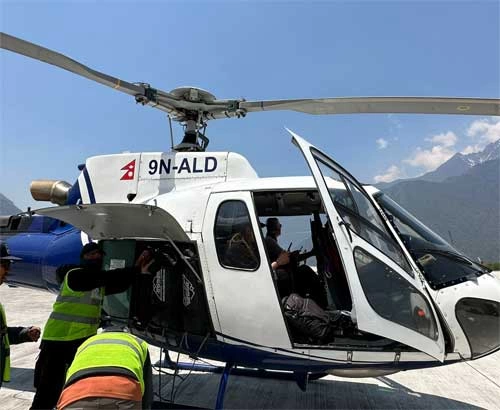How Much Does Everest Base Camp Trek Insurance Cost In 2026?
If you're planning the Everest Base Camp trek, you should anticipate spending around $100 to $300 for a trek-suited insurance plan.
To give you an idea, here are some prices from local Nepal‑based insurers: They're offering prices starting at roughly US$95 for a short-duration policy (7 days) that covers altitude up to 5,500m approximately.
For 21 days it's more like US$120 term when you add proper high‑altitude and evacuation cover. The price varies widely based on a few main factors: the length of your trek, the maximum altitude your policy will cover, your age, where you are coming from, and how much medical and evacuation coverage (if any) doesn't include a helicopter rescue operation. Most 'normal' travel insurance policies don't include trekking at altitudes above an average of 3,000-4,000 meters, so make sure your policy clearly states 'trekking up to 6,000m', or something similar.
We are a tour operator partner, so we recommend putting the insurance cost into your budget early in your planning. Budget at least US$150–250 for such a policy on a standard 14‑to 21‑day trek that includes coverage up to high altitude and flight evacuation. If you are older, have pre‑existing conditions, or will embark on a longer itinerary, you may pay at the higher end of the US$300 range or more.
For 21 days, it's more like US$120 term when you add proper high‑altitude and evacuation cover. The price varies widely based on a few main factors: the length of your trek, the maximum altitude your policy will cover, your age, where you are coming from, medical and evacuation coverage whether helicopter rescue is included or not.
Most 'normal' travel insurance policies don't include trekking at altitudes above an average of 3,000-4,000 meters, so make sure your policy clearly states 'trekking up to 6,000m', or something similar.
As a Tour operator partner, we recommend putting the insurance cost into your budget early in your planning. Budget at least US$150–250 for such a policy on a standard 14‑to 21‑day trek that includes coverage up to high altitude and flight evacuation. If you are older, have pre‑existing conditions, or will embark on a longer itinerary, you may pay at the higher end of the US$300 range or more.
Trekkers typically understand the need for insurance when climbing to base camp on Mount Everest; however, few are certain which type of insurance they need or how much they should spend on it. In order to avoid this in a potentially very dangerous situation, it is important to ensure that your insurance policy provides coverage for the location you plan to visit, and for any high altitude trekking, medical emergencies, and emergency helicopter evacuation needed in the event of an injury. Follow the general outline below of what type of insurance costs to plan for.
Benefit | Cost-Level near to US$ 150 | Cost-Level near to US$ 200 |
Altitude Coverage | Up to near to 5,500 m | Up to near to 6,500 m |
Geographical Scope of Travel | Nepal or worldwide | Same, depending on plan |
Sum Insured | near to US$ 200,000 for medical & evacuation | Same (near to US$ 200,000) |
Maximum Trip Duration | near to 45 days | near to 15 days |
Age Limit | Up to near to 69 years | Up to near to 65 years |
Medical Expenses | Covered, including altitude-related illness | Covered, including altitude-related illness |
Medical Evacuation (Including Helicopter) | Covered, pre-authorization required | Covered, pre-authorization required |
Personal Accident (Death & Disability) | Covered | Covered |
Loss of Checked‑In Baggage | Covered (up to policy limit) | Covered (up to policy limit) |
Loss of Passport & Driving License | Covered (small limit) | Covered (small limit) |
Trip Cancellation / Interruption | Covered (non-recoverable trip costs) | Covered (non-recoverable trip costs) |
Hijack Distress Allowance | Sometimes included (near to US$ 300) | Same if included in plan |
Daily Allowance in Case of Hospitalization | near to US$ 70/day up to max days | near to US$ 70/day up to max days |
Repatriation of Mortal Remains | Covered (up to high limit) | Covered (up to high limit) |
Special Policy Features | 24/7 emergency assistance, pre-approved helicopter rescues | Same, may include high-value item riders |
Premium (per person) | near to US$ 145 for 45-day, up-to-5,500 m plan | near to US$ 205 for 15-day, up-to-6,000+ m plan |
Eligibility | Trekkers (non-technical), altitude-trekking plan required | Same, high-altitude/add-on required |
Covid‑19 Coverage | Usually included for medical expenses | Usually included for medical expenses |
Everest Base Camp Trek Insurance Price Estimates as per the Itineraries
1. Everest Base Camp Trek (15 Days)
The 15-Day Everest Base Camp trek is one of the classic and famous hiking trails in the world, which will blow your mind to admire the mysterious beauty of the Himalayas and the pride on top of the world, Mount Everest. 4-5 hrs a day, this walk leads you to an attractive Sherpa village and through forested and alpine nature.
With adequate acclimatization days, it ensures a safe trek to the Everest Base Camp (5,364 m). Along the way, you'll get breathtaking glimpses of Everest, Lhotse, and other majestic peaks it's an adventure of a lifetime.
Outline Itinerary:
- Day 1: Arrival in Kathmandu, Nepal
- Day 2: Flight to Lukla and trek to Phakding
- Day 3: Trek from Phakding to Namche Bazaar
- Day 4: Rest day in Namche for acclimatization
- Day 5: Trek from Namche Bazaar to Tengboche
- Day 6: Trek from Tengboche to Dingboche
- Day 7: Rest day in Dingboche for acclimatization
- Day 8: Trek from Dingboche to Lobuche
- Day 9: Trek from Lobuche to Gorakshep
- Day 10: Visit Everest Base Camp and return to Gorakshep
- Day 11: Trek to Pheriche
- Day 12: Trek back to Namche Bazaar
- Day 13: Trek from Namche to Lukla
- Day 14: Flight back to Kathmandu
- Day 15: Departure or optional sightseeing in Kathmandu
Cost (per person)
For Indian Nationals:
- 1-49 years: INR 8,500 (15 Days)
- 50-59 years: INR 12,750 (15 Days)
- 60-69 years: INR 17,000 (15 Days)
For Foreign Nationals:
- 1-39 years: USD 85 (7 Days)
- 40-49 years: USD 100 (7 Days)
- 50-59 years: USD 120 (7 Days)
Everest Base Camp Trek (12 Days)
The 12‑day trek to Everest base camp is a short but very comprehensive adventure through the High Himalayas of Nepal. You start with a picturesque flight from Kathmandu to Lukla Airport, and then hike through rugged landscapes past villages like Namche Bazaar and monasteries like Tengboche Monastery, gradually gaining altitude so your body can acclimate.
Most days are 4–6 hours hiking on mountain trails, averaging 8 to 15 km per day.
On the last stretch, you arrive at Base Camp at 5,364m a dream‑come‑true panorama of the Himalayas and the Khumbu Icefall.
Outline Itinerary
Day 1: Arrival in Kathmandu, transfer to hotel
Day 2: Kathmandu to Lukla flight, trek to Phakding
Day 3: Phakding to Namche Bazaar
Day 4: Acclimatization day at Namche Bazaar
Day 5: Namche Bazaar to Tengboche
Day 6: Tengboche to Dingboche
Day 7: Acclimatization day at Dingboche
Day 8: Dingboche to Lobuche
Day 9: Lobuche to Gorak Shep, hike to Everest Base Camp, return to Gorak Shep
Day 10: Gorak Shep to Pheriche
Day 11: Pheriche to Lukla
Day 12: Lukla to Kathmandu flight, transfer to hotel and departure preparation
Cost (per person)
For Indian Nationals (12 Days):
- 1-49 years: INR 8,500 (12 Days)
- 50-59 years: INR 12,750 (12 Days)
- 60-69 years: INR 17,000 (12 Days)
For Foreign Nationals (12 Days):
- 1-39 years: USD 95 (12 Days)
- 40-49 years: USD 100 (12 Days)
- 50-59 years: USD 191 (12 Days)
2. Everest Base Camp Short Trek (10 Days)
The Everest Base Camp Short Trek (10 days) is perfect for people with a limited amount of time but who still want to explore the Everest region of Nepal. In a shorter EBC adventure, you will traverse the stunning Khumbu Valley and reach the most iconic Base Camp on earth in just 10 days.
Sherpa culture, spectacular scenery, panoramic views of Everest and Lhotse and close-up encounters with sacred peaks are all provided along with good acclimatization. A speedy yet memorable journey to one of the world’s most famous trekking destinations.
Outline Itinerary:
Day 1: Arrival in Kathmandu
Day 2: Flight to Lukla and trek to Phakding
Day 3: Trek from Phakding to Namche Bazaar
Day 4: Rest day in Namche for acclimatization
Day 5: Trek from Namche Bazaar to Tengboche
Day 6: Trek from Tengboche to Dingboche
Day 7: Trek from Dingboche to Lobuche
Day 8: Trek to Gorakshep, visit Everest Base Camp
Day 9: Return trek to Pheriche
Day 10: Trek to Lukla and fly back to Kathmandu
Cost (per person)
For Indian Nationals:
- 1-49 years: INR 11,500 (21 Days)
- 50-59 years: INR 17,250 (21 Days)
- 60-69 years: INR 23,000 (21 Days)
For Foreign Nationals:
- 1-39 years: USD 150 (14 Days)
- 40-49 years: USD 200 (14 Days)
- 50-59 years: USD 275 (14 Days)
3. Everest Base Camp Classic Trek (21 Days)
Classical Everest Base Camp Trekking is the classical route in the Everest region, and has been followed for many years since being recognized as a trekking destination. It starts with a spectacular flight from Kathmandu into the Khumbu, and treks through Sherpa villages, rhododendron forests, and high alpine landscapes.
Time is built in to acclimate at higher altitudes, as well as climb to the summit of Gokyo Ri (5,483m) for wide-reaching views across the Himalayas, pass over the Cho La Pass (near 5,300m), and finish with a visit to Everest Base Camp and neighbouring viewpoints Kala Patthar. This trek has it all: culture, challenge, and unforgettable views over the course of 21 days.
Outline Itinerary
Day 1: Arrive in Kathmandu (1,400 m) and transfer to a hotel.
Day 2: Drive to Junbesi (2,675 m) – 11–12 hrs.
Day 3: Trek to Nunthala (2,440 m) – 5–6 hrs.
Day 4: Trek to Kharikhola (2,257 m) – 5–6 hrs.
Day 5: Trek to Puiyan (2,760 m) – 5–6 hrs.
Day 6: Trek to Phakding (2,610 m) – 6–7 hrs.
Day 7: Trek to Namche Bazaar (3,440 m) – 5–6 hrs.
Day 8: Acclimatization day in Namche.
Day 9: Trek to Phorste Thanga (3,680 m) – 5–6 hrs.
Day 10: Trek to Machherma (4,470 m) – 5–6 hrs.
Day 11: Trek to Gokyo (4,790 m) – 5–6 hrs.
Day 12: Hike Gokyo Ri (5,357 m) and return to Gokyo – 5–6 hrs.
Day 13: Trek to Thangna (4,500 m) – 4–5 hrs.
Day 14: Cross Cho La Pass (5,420 m) to Dzongla (4,830 m) – 7–8 hrs.
Day 15: Trek to Lobuche (4,910 m) – 4–5 hrs.
Day 16: Trek to Everest Base Camp (5,364 m) and back to Gorak Shep – 8–9 hrs.
Day 17: Hike Kala Patthar (5,555 m) and descend to Pheriche (4,240 m) – 7–8 hrs.
Day 18: Trek to Namche Bazaar – 6–7 hrs.
Day 19: Trek to Lukla – 6–7 hrs.
Day 20: Fly to Kathmandu (or Ramechhap + drive) and overnight stay.
Day 21: Transfer to Airport
Cost (per person)
For Indian Nationals:
- 1-49 years: INR 15,600 (30 Days)
- 50-59 years: INR 23,400 (30 Days)
- 60-69 years: INR 31,200 (30 Days)
For Foreign Nationals:
- 1-39 years: USD 225 (21 Days)
- 40-49 years: USD 275 (21 Days)
- 50-59 years: USD 350 (21 Days)
4. Everest Base Camp Trek (30 Days)
Everest Base Camp Trek 30 is Best for trekkers who want to become fully engaged in the Everest Region . The trek is a less demanding one that includes extra acclimatisation days and lets you savour the beautiful scenery, Sherpa culture, and stunning views of Mount Everest. The fuller 30-day journey allows you a much slower, more leisurely pace for trekkers wanting to fully experience the region.
Cost (per person)
For Indian Nationals (30 Days):
- 1-49 years: INR 31,000 (60 Days)
- 50-59 years: INR 46,500 (60 Days)
- 60-69 years: INR 62,000 (60 Days)
For Foreign Nationals (30 Days):
- 1-39 years: USD 300 (30 Days)
- 40-49 years: USD 350 (30 Days)
- 50-59 years: USD 450 (30 Days)
What do Travel Agencies Running the Everest Base Camp trek suggest?
Agencies emphasise that standard travel insurance is inadequate for the Everest region. There is enormous risk for trekkers, including high‑altitude sickness (AMS, HAPE, HACE), dangerous terrain with no access to help or rescue, immediate and crazy weather changes at the drop of a hat and emergency helicopter evacuations.
Medical evacuation from the mountains can cost US$5,000–10,000 or more easily for those without proper coverage.
Hence, agencies require Policies that specifically cover high‑altitude trekking and evacuation services.
- Many guides say to plan for near to US$100‑300 for decent coverage on a 2‑4 week EBC trek.
- On the low end: Basic policies begin at around US$100+, once they include basic evacuation/medical services.
- On the upper end: full coverage plans (trip cancellation, etc) fall above US$200‑300+.
Note: Some forums cite European contrasts: “About £200 each” for similar high‑altitude trekking policies.
Key components travel agencies look for in your policy
- Finally, coverage of trekking to 5000 or 5500-600m at least, because EBC is around 5364m.
- Emergency evacuations, which could include helicopter retrieval from isolated high‑elevation locations.
- Coverage for medical evacuation/medical expenses (hospitalisation conditions, treatment in Nepal or with an opportunity to be evacuated to home) and trip cancellation/flight‑delay protection (specific flights arriving/departing from Lukla).
- Clear exclusions: Many standard travel policies exclude higher altitude trekking or evacuations above specific lower altitudes.
Agencies organising the Everest Base Camp trek are very firm, insurance is not something to be considered, but an absolute necessity. Budget anywhere between US$100-300 for a decent high‑altitude trek insurance policy (for 2-4weeks) but that doesn’t mean it could cover you at altitude with evacuation, so double-check what’s included before getting something. With the right policy, you’ll travel with peace of mind and feel confident that you’re ready if anything unexpected happens.
Travel Insurance Cost for Everest Hike as per nationality
Country | Currency | Approx Premium |
United States | USD | near to US$250‑400 |
Canada | CAD | near to CAD 350‑550 |
United Kingdom | GBP | near to £180‑300 |
Australia | AUD | near to A$300‑500 |
New Zealand | NZD | near to NZ$320‑520 |
Germany | EUR | near to €220‑380 |
France | EUR | near to €220‑380 |
Switzerland | CHF | near to CHF 230‑390 |
Netherlands | EUR | near to €220‑380 |
Sweden | SEK | near to SEK 2,500‑4,300 |
Japan | JPY | near to ¥35,000‑60,000 |
India | INR | near to ₹11,000‑20,000 (for domestic specialised trek insurance) |
China | CNY | near to ¥1,800‑3,000 |
South Korea | KRW | near to ₩300,000‑500,000 |
South Africa | ZAR | near to ZAR 4,000‑7,000 |
Brazil | BRL | near to R$1,200‑2,000 |
Mexico | MXN | near to MXN 4,500‑7,500 |
Russia | RUB | near to RUB 18,000‑30,000 |
United Arab Emirates | AED | near to AED 920‑1,500 |
Saudi Arabia | SAR | near to SAR 900‑1,500 |
Argentina | ARS | near to ARS 45,000‑70,000 |
Chile | CLP | near to CLP 220,000‑350,000 |
Colombia | COP | near to COP 900,000‑1,400,000 |
Turkey | TRY | near to TRY 7,000‑12,000 |
Poland | PLN | near to PLN 900‑1,500 |
Hungary | HUF | near to HUF 90,000‑150,000 |
Czech Republic | CZK | near to CZK 5,000‑8,000 |
Thailand | THB | near to THB 9,000‑14,000 |
Malaysia | MYR | near to MYR 1,100‑1,800 |
Indonesia | IDR | near to IDR 1,600,000‑2,800,000 |
Vietnam | VND | near to VND 2,500,000‑4,000,000 |
Main Factors That Influence the Cost of the EBC Trek Insurance
Duration of Trek and Number of Days
Your trip length generally acts as a main factor for premium cost with insurance carriers. A longer trek means greater risk exposure (altitude‑related illness, change in weather conditions, need for evacuation) over a larger number of days and therefore a higher probability of making a claim. For instance, a 30‑day policy for high‑altitude trekking costs around USD300 or more.
If your itinerary is longer than average (say, 14–16 days) or allows extra buffer days for acclimatisation, inclement weather and transport back to KTM from the mountain, you're effectively buying more exposure time, so premiums tend to increase.
Age of the Trekkers and Pre-existing Conditions
Age is important because older travellers are more likely to need medical treatment or evacuation, so insurers charge higher premium rates. The policy premiums increase with advancing age or if you have disclosed pre‑existing medical conditions (heart, lung, etc.) that automatically place an individual at higher risk of altitude sickness/complications.
Age of the Trekkers and Pre-existing Conditions
Age is important because older travellers are more likely to need medical treatment or evacuation, so insurers charge higher premium rates. The policy premiums increase with advancing age or if you have disclosed pre‑existing medical conditions (heart, lung, etc.) that automatically place an individual at higher risk of altitude sickness/complications.
Failure to disclose a medical condition may result in your claim being declined. Therefore, insurance companies either exclude these "pre‑existing conditions" from coverage or impose an increased premium for them. The premium you will be charged for the level of coverage you choose will increase as your age increases.
Country of Origin and Insurance Provider Region
The country you reside in and the country from which you purchase insurance can also influence the amount you will pay, as insurance companies calculate the risk associated with different regions and thereby adjust their premiums accordingly. Insurance companies will also consider the costs associated with local emergency services and how foreign currency fluctuations may impact their premium prices.
Some insurance companies issue policies specifically for trekkers purchasing from their country of residence, while other companies may refuse to offer coverage due to the perceived risk of providing coverage for individuals residing in certain regions; in addition, insurance companies may charge an additional premium for this exposure to risk.
Trekkers who have utilised the route to high altitudes have reported that many companies will not cover high-altitude trekking for individuals from certain regions, and as a result, finding coverage becomes increasingly difficult and more expensive.
In addition to the country of origin of the insured (the region from which coverage is purchased), the country of the insurance company can also influence the cost of high-altitude rescue insurance. Companies that operate as international insurance providers and offer high-altitude rescue will generally be more expensive than a local insurance provider that may only provide limited amounts of high-altitude coverage.
Altitude Limit and Included Activities (Guided/Unguided)
High altitude trekking adds significant risk (e.g., altitude sickness, helicopter evacuation, severe weather) and quite a few regular travel insurance plans limit coverage of low altitude (e.g., 3,000m) or have exclusions on guided vs unguided adventure sports. For the EBC trek, you want a policy that specifically covers altitudes up to 6,000m (in fact, you might want more than that).
If you’re trekking unguided, or if you are planning some optional activities (say doing a helicopter return, or a side climb, or much off‑trail), insurers consider that as being higher risk the premium goes up, or they’ll have an added “adventure sports” special. Whatever happens with these things, one has to make sure their coverage is adequate. So both their altitude limit plus whether you are in a guided group (which is lower risk) vs unguided (higher risk) will affect cost.
When to Purchase the Insurance For EBC Trekking in Nepal?
1. As soon as you book your flights and trek package (ideally 3–6 months out)
- Once you have your trek date located and flight booked, this is the best time to begin shopping for insurance. If you buy early, that way you will have coverage for:
- Trip Cancellation or Interruption (Occurs before you leave)
- Delays or cancellations for the flight might mean your trek wouldn’t start
- Pre-existing medical conditions (if you have them listed on your policy)
- Many plans must be purchased before your trip starts or by the time you leave your home country.
2. Around 4–6 weeks before departure
- By now, you should have finalised your policy. Just ensure that the coverage clearly states:
- Hiking at altitude (EBC is near 5,364m, and some of the side trips go higher. fetchall
- Helicopter evacuation in remote/high‑altitude terrain
- Full-length coverage (including days of travel)
- Purchasing at this point still allows you to compare providers and upgrade if need be, but you’re approaching nearer departure, so it’s essential not to leave it too late.
3. Last minute – within 1–2 weeks of departure (riskier)
- You can buy insurance in the week or two leading up to your trip, but there are risks and restrictions:
- There are some providers that will not cover you if your journey/trip has already started.
- The coverage for trip cancellation is limited (due to many events they protect against having already occurred prior to the policy becoming effective).
- Premiums could be greater, or the choice of plans more restricted
- If you’re in this window, ensure that your selected provider specifically states coverage begins before you leave and includes the trek’s altitude.
4. Avoid buying insurance after arrival in Nepal or once trekking has begun
Many guides and blogs also warn that if you attempt to buy insurance after you arrive in Nepal, or after you begin your trek, it might be too late and key coverages might not apply.
If you wait until you are already in Nepal, you forgo coverage of territory-specific events such as trip cancellation and delay of flights into the country, and some insurers may institute waiting periods.
5. Maintain proof and double‑check details just before departure
- Once you have bought the policy, but just before leaving your home country, you will need to:
- Print and keep a hard copy and store a digital copy of the certificate.
- And double-check with your trekking agency and make sure they’ll accept the coverage, and ensure that their altitude/evacuation policy is covered in your particular plan.
- Have emergency contact numbers, insurance policy reference and also understand the claim process.
Cheapest Insurance for EBC Trek
Lowest Cost for Cheapest Insurance
For an Everest Base Camp (EBC) trek, you can find extremely basic high-altitude trekking insurance (including emergency evacuation) from as little as US$100 for a 2-3 week policy. This is a low-end EBC trek insurance cost.
Basic coverages to 6,000 m altitude are frequently in the US$100–150 range (some reports). But watch out: the very cheapest policies might not cover all the right things, like helicopter rescue or high enough altitude.
How can it be so cheap?
- Low altitude coverage limits / minimal medical cover
- Low limit of altitude on the policy (some cheap ones will go up to 4,000 m, but that’s not enough for EBC, as it sits at 5,380).
- Exclusions: basic plans might not cover trip cancellation, or may exclude “adventure activities.”
- Deductibles: Less expensive plans can carry higher deductibles for either rescue or medical.
Highest Cost for “Cheap” (or the Upper-End of What’s Still Considered Budget but Safe)
Towards the upper end of “reasonable but still budget-friendly” for EBC level trekking insurance, you can expect to pay 250–300 USD for 2–3 weeks.
Some quite premium plans, ones that have generous medical cover, trip cancellation, baggage and high evacuation cover, fall into this range due to the risk of being at altitude.
Why does this cost more?
- More medical coverage (insurance will pay for more costly hospital stays or treatments).
- Greater evacuation coverage (it is expensive to be rescued by a helicopter in the Himalayas).
- More “add-ons”, for example, trip interruption/cancellation, luggage, and “adventure trekking” coverage.
- Higher altitude limits: plans will also often specifically mention trekking up to or above 6,000 meters, which is higher than EBC and Kala Patthar.
Best Travel insurance for Everest Base Camp Trek in 2026
World Nomads
- Trek altitude: EBC is at approximately 5,364m (17,598ft).
- Coverage: Their website says "hiking up to 19,685ft (near to 6,000m) … is covered" through their program for Nepal.
- Main hazards: altitude sickness (AMS/HAPE/HACE), helicopter evacuation, weather conditions and related flight delays (to/from Lukla) & remoteness.
Why is this provider good?
Many EBc Adventure travellers use WorldNomads. They specifically mention Nepal and high‑altitude trekking in their destination coverage. If you choose the right level plan (frequently their "Explorer", or above), it covers trekking up to 6,000m as well as helicopter evacuation. This makes it a good choice for the Mount Everest Base Camp Hike.
Estimated cost
Estimated Price: $150 - $300 USD for a 2 - 3 week trek to EBC, depending on age, area of residence and time of travel
True Traveller
- Covering: they cover 'Trekking up to approx. 6000m' for UK/European travellers (with appropriate add-on)
- What is included: emergency medical + evacuation, luggage, and delayed flight
- Best Suited for: Trekkers originating from Europe/UK
Why should you consider this company?
If you're travelling to EBC and coming from the UK/Europe, True Traveller offers adventure travel packages that fit your high-altitude trekking needs. True Traveller will provide coverage up to approx. A 6000m limit when selecting the correct premium upgrade.
They are explicit that customers need to select the high altitude add-on.
Estimated Price: One user stated that they purchased Insurance that covered their trekking to approximately 6000m approximately £200 (approx. US $260-$300) from the UK.
SafetyWing
- Base coverage: Their standard policy provides cover up to near to 4,500m.
- Add-on: "Adventure Sports" or high altitude upgrade can take you up to near to 6,000m.
- Best for: Extended travel, digital nomads, budget-conscious travellers.
Why do we think this is a good provider?
SafetyWing strikes the balance of being both a budget option and flexible (think monthly subscription style), which is perfect if you plan to spend some time in Nepal beyond the trek itself or are linking it with other travel.
But you need to make sure an upgrade for high‑altitude trekking is included and that it also provides for helicopter evacuation. Those might not be included in many budget plans.
Estimated cost
A more affordable alternative: around US$90–150 for a 2‑3 week trek with the right add‑on.
IMG Global
- Created for: High‑altitude treks such as EBC, etc.
- Coverage: Up to 6,000m and Altitude Evacuation (Strong)
- Particularly good for: US/UK/Australia-based trekkers looking to aim for some serious altitude.
Why this provider is good?
IMGGlobal has a Bespoke cover for mountaineering and high altitude trekking. Their policy maximums and repatriation coverage are stronger than the typical travel insurance. On a hike like EBC, where evacuation and altitude things are important, this is a very good bet.
Estimated Cost
You can also expect a premium because of the higher altitude and rescue cover. Approximately US$200‑400 for a quality cover.
Allianz Travel (Allianz Global Assistance)
- Coverage: Standard plans will only cover up to approximately 4,000-5,500m based upon plan/region.
- Strengths: Big global brand, good medical cover and trip‑cancellation benefits.
- Warning: Ensure you purchase the right plan/add‑on that offers coverage for altitude.
Why this provider is Good?
If you’re looking for a well-known international travel insurer and you are okay with verifying that your altitude and evacuation cover is suitable, Allianz would be good. They have strong medical benefits. There is also the global network. But for EBC, you’ll want to make sure your plan covers over near to 5,300m and includes helicopter evacuation or else you may be under‑covered.
Estimated cost
Expect to pay US$100‑200 for a 2‑3week high-altitude trek cover, depending on the plan.
What Coverage You Should Look For Everest Base Camp Insurance?
Medical Treatment & Hospitalisation
Your insurance policy has to cover treatment for illness and injury when you’re not at home. On the EBC trek, you’re walking in a very remote area at high altitude, where even something that seems like it’s no big deal (like altitude sickness) can turn into something serious. As one guide puts it, “major medical emergencies in remote locations” are a very real concern.
In practical terms, you want:
- Hospitalisation cover (both in‑country and possibly the repatriation kind)
- Doctor, medication, diagnostics (for altitude sickness, HAPE/HACE, etc.
- Coverage against sudden ill or accident (even though you were healthy previously)
- Limits high enough that you won’t have to pay huge bills out‑of‑pocket
Emergency Evacuation (including Helicopter Rescue)
The most critical part of EBC is helicopter rescues. If you are at a higher elevation, for example, 5000 m, and something happens to you (i.e. altitude sickness or similar), there may not be ground access possible, and the only solution is a helicopter rescue. Most policies do not provide coverage unless it is specifically noted. According to one of my guides, "many policies will provide coverage for medical treatment but will specifically exclude helicopter rescue which is by far the most important coverage you will require."
Please ensure that the specific policy details are as follows:
- Helicopter evacuation from a remote base and/or a high-altitude environment.
- Appropriate hospitalisation after the helicopter has evacuated you.
- Helicopter evacuation should be considered an integral part of the basic travel insurance plan and not an expensive add-on (unless you have the option of an add-on).
- 24 hr emergency response/rescue coordination is provided.
Trip Cancellation, Delay, and Baggage Loss
There are so many moving parts on the EBC trek, such as: flights (e.g., to/from Lukla), treks getting delayed because of weather being tough, landslides occurring and losing or delaying all your gear, etc. So your insurance policy ought to cover you for:
- Cancellation (pre‑trek) / interruption (mid‑trek) of the trip due to sickness, bad weather or strikes, etc.
- Trip break (if your flight to Lukla is cancelled)
- Lost or damaged baggage (the gear you are trekking with is expensive and important)
- Lost or damaged baggage and trekking gear
- So you want a policy that provides financial recourse if things go bad.
Coverage Limits and Altitude Restrictions
This is where a lot of tourists mess up. A typical travel insurance policy will exclude (or only cover up to 3,000-4,000m) high‑altitude trekking, and the EBC hits 5,364m (17,598ft), and there are side‑trips which climb significantly higher. As per local EBc guides “A policy that only pays to 3,000 or 4,000 meters is worthless on a trek that climbs higher than 5,300 meters.”
Here’s what to check carefully:
- The highest altitude of the trekking/hiking done (e.g., up to 6,000m)
- The type of activity: “trekking” or “high altitude trekking” vs plain “hiking”
- Any exceptions for specific elevations or locations
- If cover for evacuation, medical and repatriation is required above 5,000 meters.
- The policy will be in effect throughout your trip (including delays).
Tips to Choose the Right Provider
- Consider your own risks: Are you hiking at a high altitude (near or above 5,000m), in remote areas, and may need helicopter rescue? Make sure the provider expressly covers those.
- Be sure to read the fine print: What types of activities are covered (trekking, high‑altitude hiking)? What altitude limit? What exclusions? Cheapest isn’t always best.
- Verify the provider is reputable: Make sure they offer 24/7 emergency support, check their reputation, and review the claims process. Real-traveller reviews help.
- Buy early and customise: Before you pack your bags, it’s wise to have a policy that covers cancellations, delays and such as soon as any part of the trip has been paid for; check first to ensure that coverage will be available along your full route and for whatever dates you plan.
- Compare cost vs value: Premiums depend on age, duration, elevation and add-ons. When you select less expensive, don’t choose cheap.
- Check global credentials: Be aware that you will be in Nepal and off the beaten track, so select a provider with good coverage at a global level and support in this region.
- Check altitude & evacuation cover: You need high‑altitude insurance and helicopter evacuation . If you’re an EBC trekker without that, your policy isn’t sufficiently comprehensive.
- Get everything in writing: Make sure your trip route and activities (EBC trek) are declared and approved in the plan surprises arise on claims largely because of undeclared activities.
- Keep policy details handy on the trek: Carry your digital and print copies, emergency number, claim process and the person in whose name including their phone number is registered with the insurer.
What does Adventure Altitude Treks Travel Operator Rohit Says?
If you’re paying the highest price you may not always be buying quality travel insurance. At the end of the day it doesn’t matter whether you are or not as long as your policy covers risk related to high-altitude trekking, includes emergency evacuation/heli rescue and is tailored specifically to match the elevation and geography of where you’ll be trekking. A well‑selected mid‑priced policy that has all the right things covered can be worth much more than an expensive plan with lots of exclusions. Match the altitude limits, evacuation cover and trip delay/cancellation benefits to your itinerary before you buy-and you’d get full protection without over‑paying.
Final Thoughts
For a 2‑ to 3‑week trek to Base Camp, expect to pay US$100‑300 for insurance (if and only if it covers high‑altitude trekking and evacuation).
The cost varies widely based on your age, nationality, cover duration, altitude limit and provider. Cheaper policies may have starting points in the lower end of that range; however, if you require full evacuation cover, high medical limits and altitude coverage up to around 5,500‑6,000m, then you are looking at the higher side.
Do not choose a policy based on cost alone. Select one that actually covers trekking at high altitude and emergency rescue. The added expense is trivial in comparison to the hazard.
FAQS Related to Everest Base Camp Trek Insurance Cost
Does the Standard travel insurance cover the EBC trek?
many typical travel‑insurance policies will not cover high‑altitude trekking, or activities above a certain altitude (usually in the 3,000–4,000m range). As EBC goes near to 5,364m so general policies may not work.
What happens if I arrive in Nepal should I register or inform someone about my insurance?
Yes, it’s a good idea to have your insurance registered with your trekking company, with a copy of the Insurance Certificate, and mention emergency contact numbers. If you need to be evacuated, your guides will use this information to approve for rescue.
How expensive can helicopter rescue be if insurance doesn’t cover it?
A helicopter evacuation in the Everest region may cost USD 5,000–10,000 or more. Without proper insurance, you might need to pay that out of pocket.
Why does the choice of trekking company matter for insurance and safety?
With a good, reliable trekking company, there will always be acclimatization days and proper rescue processes in place. Some unscrupulous operators hurry treks or bypass acclimatization increasing the risk of altitude sickness and occasionally prompting evacuations that insurance won’t cover.
What are the most common altitude‑related risks on EBC trek?
Even the fittest of trekkers can be victims of Acute Mountain Sickness (AMS), High Altitude Pulmonary Edema (HAPE), or High Altitude Cerebral Edema (HACE). In remote areas, these will mean immediate descent or helicopter evacuation all the more reason to ensure you have high‑altitude cover.
Should getting the right insurance be a priority before trek departure?
As high‑altitude trekking and evacuation are usually not included as standard cover with most policies, it is a must-have to safeguard yourself against medical emergencies, expensive evacuations, trip delays or cancellations, and loss of gear. Better safe than sorry.
Is travel insurance mandatory for EBC treks?
Not strictly, thousands of trekkers head up without it. But nearly all guide companies expect you to show proof of insurance before they let you join the group, and because of the altitude, remoteness, and potential for emergencies, insurance is seen as a must-have for safety and peace of mind.
Does insurance cover cancelled or delayed flights (e.g. Lukla flights)?
Yes, good trekking insurance should cover flight cancellations or delays, and this is particularly important given flights to/from the EBC region can all too easily be delayed/AFA. If your schedule gets disrupted, this can save you big money.
Can I insure my trekking gear and luggage?
Yes, in many instances, most policies cover lost, stolen , or damaged bags and gear. That’s helpful because trekking gear (boots, sleeping bags, jackets) can get expensive, and replacing them mid‑trek might be difficult.
